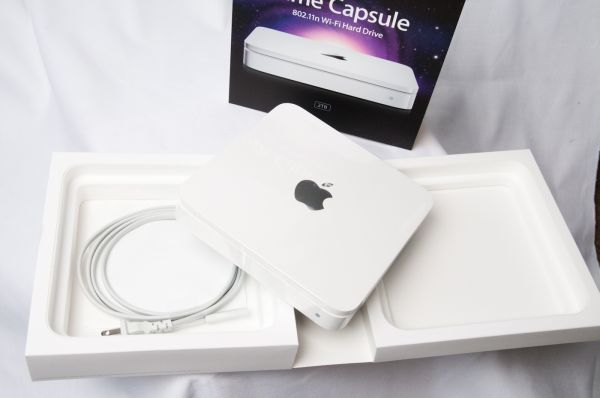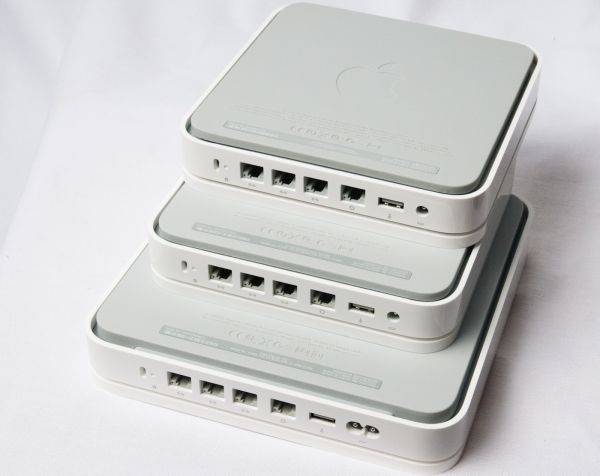Airport Extreme (5th Gen) and Time Capsule (4th Gen) Review - Faster WiFi
by Brian Klug on August 5, 2011 10:22 PM EST- Posted in
- Mac
- Airport Extreme
- Time Capsule
- WiFi
Apple has been playing it cool on the WiFi side of things lately. It started with the previous Airport Extreme (Gen 4) which quietly introduced three spatial stream support, followed up by the Early 2011 MacBook Pro update which brought a three spatial stream compliant WLAN stack, and now has continued with an even more understated update for the Time Capsule (4th generation) and Airport Extreme (5th generation).
Both updates launched just prior to this latest round of Apple launches, which included the Mac Mini, Macbook Air, and Thunderbolt Display, but unlike those three, the Time Capsule and Airport Extreme updates saw almost no mention. Starting with the exterior packaging, you’d be hard pressed to tell that a particular Time Capsule or Airport Extreme is the newer refresh. I no longer have the old Airport Extreme packaging, but the new device box is virtually indistinguishable. Outside of bumping the supported storage capacity for the Time Capsule up to 3TB, there’s no real obvious giveaway for the Time Capsule either.
The only way to tell which version is which by looking at the box is by the model numbers—MD031LL/A for the 5th generation Airport Extreme, and MD032LL/A for the 2TB 4th generation Time Capsule.
The contents of the Airport Extreme box remain the same as well, starting with the device itself on top, and underneath it, a power cable, 12 volt power supply (model A1202) and some literature about setup in a white plastic bag.
The Time Capsule box is much the same affair, with the device inside, a power cable, no power supply (since it’s internal), and some literature.
I stacked all three devices up so you can compare physically. Really the only big giveaway between the two Airport Extremes is an extra line of text on the previous generation, and of course the model number or FCC ID. Both the Time Capsule and Airport Extreme still retain the same port configuration—four GigE ports, one USB 2.0 port, power, reset, and a Kensington security slot. Those four gigabit ethernet ports can either be used as a switch, or you can use the device as a router and then the leftmost port becomes WAN and the right three become LAN.
At this point it isn’t really looking like there’s much different, but exterior appearances can be deceptive.




















90 Comments
View All Comments
Jacob Marley - Saturday, August 6, 2011 - link
On page 3..."Marvell 88E6350R 7 port GigE switch, with 5 physical interfaces, all of which support up to 10 KByte jumbo frames."
So the hardware supports jumbo frames, but does the software?
I have yet to find a home router that supports and enables jumbo frames at the switch level.
Jumbo frames make no difference for internet bound traffic but it seems to make a big difference for LAN based large data transfers.
jay2901 - Saturday, August 6, 2011 - link
brian,why do you use a separate box for nat? better firewall? curious as to what that device is...
thanks.
Brian Klug - Sunday, August 7, 2011 - link
I prefer the wealth of configuration options that going that route provides. Specifically software like Tomato, DD-WRT, or if you're really feeling daring, a FreeBSD based solution with a PHP wrapper like m0n0wall or pfSense.Just a ton more options for firewall, reporting, bandwidth tracking, QoS, e.t.c.
-Brian
danacee - Saturday, August 6, 2011 - link
Use D-link, or if you really have to Netgear.. Although only D-link I know for sure makes 5/2.4ghz N routers that never EVER have to reset and run for years. Netgear I've only seen that sort of reliability with their Wireless G routersLinksys is rotten filthy garbage just like everything else Cisco makes, avoid it. They've not made a single wireless router in the past 2 years that doesn't shit itself and need a reset nearly every day.
-Your helpful networking tech.
thingi - Sunday, August 7, 2011 - link
Apple infuriate me sometimes. It would appear that the 'new' time capsule still can't join a wireless network without it's Ethernet ports becoming being disabled if nothing has changed apart from the wifi card :-(My iPhone is my only source of net connection which is 80Gb (yes thats eight-zero gigabytes) of 'fair usage' per month which is oodles for a 3G connection so here's what I want to do:-
'iPhone Personal Hotspot' > Time Capsule > Airport Express (wifi-to-eth) > xbox
The trouble is that when a time capsule joins a network it's ethernet ports fall asleep. So instead I have to do the following:-
'iPhone Personal Hotspot' > Airport Express (wfi-to-eth) > Time Capsule > 2nd Airport Express (wfi-to-eth) > xbox.
The really stupid thing is that a Time Capsule is more powerful piece of network equipment than an airport express, there is no reason why the ethernet ports should fall asleep just because Apple have deemed that users must connect a Time Capsule directly with an iPhone personal hotspot without crippling it.
The other slightly annoying thing about this setup is that Apple in their infinite wisdom have deemed to force iPhone personal hotspots to set up a 'g' connection instead of an 'n' one (ok it would still be an 2.4Ghz due to the iPhone radio but that would be better than being stuck at 'g' for no good reason in a totally 'g' saturated neighbourhood!
thingi
repoman27 - Monday, August 8, 2011 - link
When you tell an AirPort Express / Extreme or Time Capsule to "Join a wireless network" it becomes a client on that network and ceases to perform as a router. This is really only useful to share attached USB or audio devices wirelessly.When you enable Personal Hotspot on an iPhone 4, it creates a wireless network (802.11n (b/g compatible), 2.4 GHz band, single spatial stream, WPA encryption) and provides DHCP and NAT to share your cellular internet connection. 802.11n connections are actually possible according to this article: http://www.anandtech.com/show/4163/verizon-iphone-... but if you're in a neighborhood where 2.4 GHz is saturated, as many are, there's not much you can do about it. Not many phones have 5 GHz WiFi radios these days.
If you just want to provide an internet connection for your Xbox, the simplest solution is to buy a WiFi adapter for it and configure that to connect to your iPhone's Personal Hotspot. In order to bridge your Personal Hotspot to your wired network, you would have to set your Time Capsule's Internet Connection: Connection Sharing setting to "Off (Bridge Mode)", set the Wireless: Wireless Mode setting to "Extend a wireless network", and then choose your Personal Hotspot as the network to extend. For various reasons, I'm going to guess that this will never work though. Besides, the iPhone Personal Hotspot only supports a maximum of 3 (GSM models) or 5 (CDMA models) clients via WiFi, so you can't really have much else on your LAN unless you put it behind yet another router.
It might be easier to tether your iPhone via USB to a Mac or PC, turn on internet connection sharing over the ethernet adapter, and then connect that to a Time Capsule set to bridge mode.
ginghus_khan2000 - Sunday, August 7, 2011 - link
I was a little surprised you didn't test the wifi and hard drives as a system. I'm sure the wifi is the limiting protocol here but there were a few spots where wifi would be faster than the hard drives.stephenbrooks - Sunday, August 7, 2011 - link
Can you stack the two Airport Extremes on their side and put the Time Capsule across the top?Brian Klug - Sunday, August 7, 2011 - link
Wow, that's an awesome idea. I'm going to see if I can set it up ;)-Brian
deadshort - Sunday, August 7, 2011 - link
Fantastic: thanks for doing that! Spread the word!If the main motherboard and chipset are the same, I guess it stands to reason that a more powerful radio would take a bit more power. ~250 Wh/day, or about 5% of my fairly careless daily consumption, is worth knowing but not worrying about.